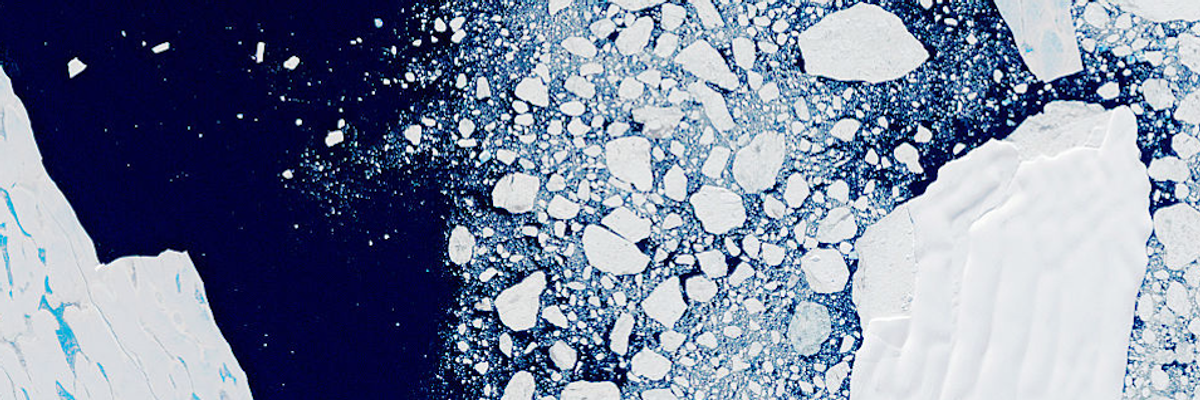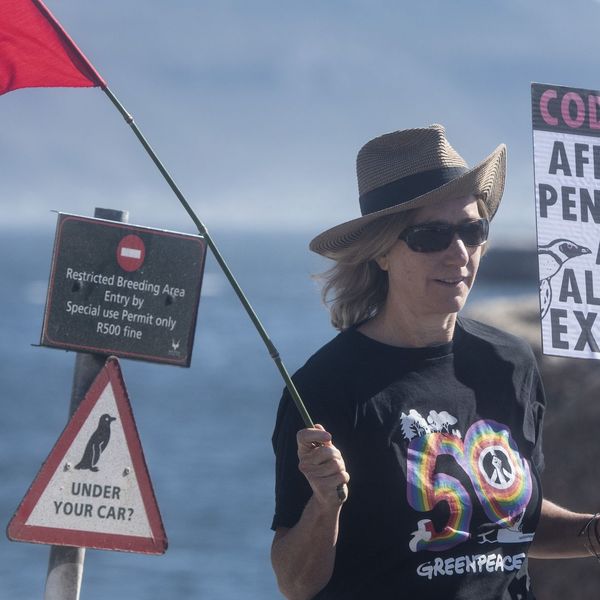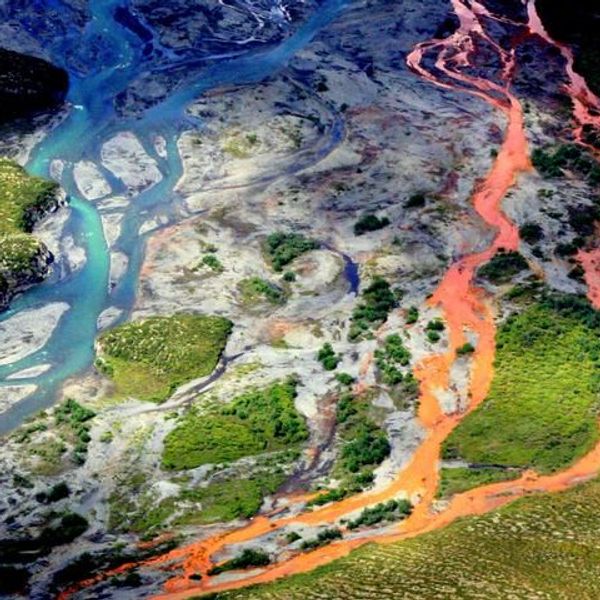
The Larsen B Ice Shelf, Antarctica. Climate change eventually led to the collapse of the Larsen B Ice Shelf in Antarctica during 2002. Satellite image taken on 21 February 2000. (Photo: USGS/NASA Landsat data/Orbital Horizon/Gallo Images/Getty Images)
'Sudden Collapse': Study Suggests 60% of Antarctic Ice Shelves Face Fracture Risk
Massive southern shelves split by climate-induced hydofracturing can collapse in hours—or even minutes—fueling dangerous sea level rise and coastal flooding.
More than 60% of the massive floating ice shelves extending from Antarctica could fracture and collapse with astonishing rapidity, a study published Wednesday in the journal Nature has found.
Climate researchers at Columbia University in New York, Edinburgh University in Scotland, and Utrecht University in the Netherlands found that surging meltwater from warmer seas could cause the ice shelves to undergo a process called hydrofracturing, which could potentially trigger ice shelf collapses within hours or even minutes. This, in turn, would accelerate sea-level rise, causing devastating coastal flooding around the world.
\u201cThe main reason, besides being intruiging a shelf the size of countries can collapse, is after an ice shelf breaks up, the land-ice that flows into it will speed up as there is no (or less) ice buttressing is, causing more ice to flow into the sea, and sea level to rise. 4/10\u201d— Melchior van Wessem (@Melchior van Wessem) 1598454827
Although ice shelves float in the ocean, they are connected to the Antarctic landmass and act as stoppers that prevent ice sheets, which are as large as the United States and Mexico combined, from breaking off into the sea. During hydrofracturing, water, which is heavier than ice, forces the fractures to tear open, causing the ice shelf to quickly deteriorate and collapse.
The researchers used remote satellite sensing, theoretical modeling, and artificial intelligence to obtain their results.
"I trained a machine learning model--a neural network, to be specific--to learn how fracture patterns look like on satellite images," Ching-Yao Lai, a postdoctoral researcher at Columbia University's Lamont-Doherty Earth Observatory and study lead author, told Gizmodo. "This is, to the best of our knowledge, the first use of machine learning on continent-scale data in the polar region."
While the study shows which ice shelves are most likely to collapse, it does not predict when such events are likely to occur.
"The time frame over which this process could happen is the biggest question," Christine Dow, the Canada Research Chair in Glacier Hydrology and Ice Dynamics at the University of Waterloo in Ontario--who was not involved in the study--told Live Science.
The new research suggests that the loss of Antarctic ice could proceed faster than some climactic models have predicted as atmospheric warming accelerates.
Earlier this week, The Observer reported that UK researchers have found that a staggering 28 trillion tons of ice have disappeared from the surface of the planet since 1994. That's enough to cover the entire land surface of the United Kingdom with a 100-meter (330-foot) sheet of ice, according to Leeds University researcher Tom Slater.
\u201cOver the last 30 years Earth has lost 28 trillion tonnes of ice! \ud83d\ude33\n\nThat's enough to cover the entire surface of the UK with ice that is 100 metres thick. \ud83e\uddca\n\nhttps://t.co/j3ZmQUfkc9\u201d— Greenpeace UK (@Greenpeace UK) 1598263236
The scientists from Leeds University, Edinburgh University, and University College London said sea-level rise due to melting glaciers and ice sheets could reach as high as 1 meter (3.3 feet) by the year 2100.
"To put that in context, every centimeter of sea-level rise means about a million people will be displaced from their low-lying homelands," Prof. Andy Shepherd, director of the Leeds University Centre for Polar Observation and Modeling, told The Observer.
A study released in February just after Antarctica recorded its highest-ever temperature, 18.3 degrees Celsius (64.9deg F), warned that catastrophic global heating was leading to "irreversible" loss of Antarctic ice.
Amid such warnings, and despite a slight and temporary decrease in greenhouse gas emissions during the coronavirus pandemic, carbon emissions are surging around the world.
In the United States, the Trump administration--which has called climate change a "Chinese hoax"--continues to roll back environmental regulations meant to mitigate what 97 percent of climate scientists concur is heating caused by human activity. Last month, the New York Times reported the administration has reversed 68 environmental rules and was in the process of scrapping 32 more.
Earlier this month, the administration announced it was finalizing plans for oil and natural gas drilling in the Arctic National Wildlife Refuge (ANWR) in Alaska, home to one of the world's largest continuous tracts of unspoiled wilderness and to indigenous peoples who depend upon the pristine land and water there for their physical and spiritual survival.
An Urgent Message From Our Co-Founder
Dear Common Dreams reader, The U.S. is on a fast track to authoritarianism like nothing I've ever seen. Meanwhile, corporate news outlets are utterly capitulating to Trump, twisting their coverage to avoid drawing his ire while lining up to stuff cash in his pockets. That's why I believe that Common Dreams is doing the best and most consequential reporting that we've ever done. Our small but mighty team is a progressive reporting powerhouse, covering the news every day that the corporate media never will. Our mission has always been simple: To inform. To inspire. And to ignite change for the common good. Now here's the key piece that I want all our readers to understand: None of this would be possible without your financial support. That's not just some fundraising cliche. It's the absolute and literal truth. We don't accept corporate advertising and never will. We don't have a paywall because we don't think people should be blocked from critical news based on their ability to pay. Everything we do is funded by the donations of readers like you. Will you donate now to help power the nonprofit, independent reporting of Common Dreams? Thank you for being a vital member of our community. Together, we can keep independent journalism alive when it’s needed most. - Craig Brown, Co-founder |
More than 60% of the massive floating ice shelves extending from Antarctica could fracture and collapse with astonishing rapidity, a study published Wednesday in the journal Nature has found.
Climate researchers at Columbia University in New York, Edinburgh University in Scotland, and Utrecht University in the Netherlands found that surging meltwater from warmer seas could cause the ice shelves to undergo a process called hydrofracturing, which could potentially trigger ice shelf collapses within hours or even minutes. This, in turn, would accelerate sea-level rise, causing devastating coastal flooding around the world.
\u201cThe main reason, besides being intruiging a shelf the size of countries can collapse, is after an ice shelf breaks up, the land-ice that flows into it will speed up as there is no (or less) ice buttressing is, causing more ice to flow into the sea, and sea level to rise. 4/10\u201d— Melchior van Wessem (@Melchior van Wessem) 1598454827
Although ice shelves float in the ocean, they are connected to the Antarctic landmass and act as stoppers that prevent ice sheets, which are as large as the United States and Mexico combined, from breaking off into the sea. During hydrofracturing, water, which is heavier than ice, forces the fractures to tear open, causing the ice shelf to quickly deteriorate and collapse.
The researchers used remote satellite sensing, theoretical modeling, and artificial intelligence to obtain their results.
"I trained a machine learning model--a neural network, to be specific--to learn how fracture patterns look like on satellite images," Ching-Yao Lai, a postdoctoral researcher at Columbia University's Lamont-Doherty Earth Observatory and study lead author, told Gizmodo. "This is, to the best of our knowledge, the first use of machine learning on continent-scale data in the polar region."
While the study shows which ice shelves are most likely to collapse, it does not predict when such events are likely to occur.
"The time frame over which this process could happen is the biggest question," Christine Dow, the Canada Research Chair in Glacier Hydrology and Ice Dynamics at the University of Waterloo in Ontario--who was not involved in the study--told Live Science.
The new research suggests that the loss of Antarctic ice could proceed faster than some climactic models have predicted as atmospheric warming accelerates.
Earlier this week, The Observer reported that UK researchers have found that a staggering 28 trillion tons of ice have disappeared from the surface of the planet since 1994. That's enough to cover the entire land surface of the United Kingdom with a 100-meter (330-foot) sheet of ice, according to Leeds University researcher Tom Slater.
\u201cOver the last 30 years Earth has lost 28 trillion tonnes of ice! \ud83d\ude33\n\nThat's enough to cover the entire surface of the UK with ice that is 100 metres thick. \ud83e\uddca\n\nhttps://t.co/j3ZmQUfkc9\u201d— Greenpeace UK (@Greenpeace UK) 1598263236
The scientists from Leeds University, Edinburgh University, and University College London said sea-level rise due to melting glaciers and ice sheets could reach as high as 1 meter (3.3 feet) by the year 2100.
"To put that in context, every centimeter of sea-level rise means about a million people will be displaced from their low-lying homelands," Prof. Andy Shepherd, director of the Leeds University Centre for Polar Observation and Modeling, told The Observer.
A study released in February just after Antarctica recorded its highest-ever temperature, 18.3 degrees Celsius (64.9deg F), warned that catastrophic global heating was leading to "irreversible" loss of Antarctic ice.
Amid such warnings, and despite a slight and temporary decrease in greenhouse gas emissions during the coronavirus pandemic, carbon emissions are surging around the world.
In the United States, the Trump administration--which has called climate change a "Chinese hoax"--continues to roll back environmental regulations meant to mitigate what 97 percent of climate scientists concur is heating caused by human activity. Last month, the New York Times reported the administration has reversed 68 environmental rules and was in the process of scrapping 32 more.
Earlier this month, the administration announced it was finalizing plans for oil and natural gas drilling in the Arctic National Wildlife Refuge (ANWR) in Alaska, home to one of the world's largest continuous tracts of unspoiled wilderness and to indigenous peoples who depend upon the pristine land and water there for their physical and spiritual survival.
More than 60% of the massive floating ice shelves extending from Antarctica could fracture and collapse with astonishing rapidity, a study published Wednesday in the journal Nature has found.
Climate researchers at Columbia University in New York, Edinburgh University in Scotland, and Utrecht University in the Netherlands found that surging meltwater from warmer seas could cause the ice shelves to undergo a process called hydrofracturing, which could potentially trigger ice shelf collapses within hours or even minutes. This, in turn, would accelerate sea-level rise, causing devastating coastal flooding around the world.
\u201cThe main reason, besides being intruiging a shelf the size of countries can collapse, is after an ice shelf breaks up, the land-ice that flows into it will speed up as there is no (or less) ice buttressing is, causing more ice to flow into the sea, and sea level to rise. 4/10\u201d— Melchior van Wessem (@Melchior van Wessem) 1598454827
Although ice shelves float in the ocean, they are connected to the Antarctic landmass and act as stoppers that prevent ice sheets, which are as large as the United States and Mexico combined, from breaking off into the sea. During hydrofracturing, water, which is heavier than ice, forces the fractures to tear open, causing the ice shelf to quickly deteriorate and collapse.
The researchers used remote satellite sensing, theoretical modeling, and artificial intelligence to obtain their results.
"I trained a machine learning model--a neural network, to be specific--to learn how fracture patterns look like on satellite images," Ching-Yao Lai, a postdoctoral researcher at Columbia University's Lamont-Doherty Earth Observatory and study lead author, told Gizmodo. "This is, to the best of our knowledge, the first use of machine learning on continent-scale data in the polar region."
While the study shows which ice shelves are most likely to collapse, it does not predict when such events are likely to occur.
"The time frame over which this process could happen is the biggest question," Christine Dow, the Canada Research Chair in Glacier Hydrology and Ice Dynamics at the University of Waterloo in Ontario--who was not involved in the study--told Live Science.
The new research suggests that the loss of Antarctic ice could proceed faster than some climactic models have predicted as atmospheric warming accelerates.
Earlier this week, The Observer reported that UK researchers have found that a staggering 28 trillion tons of ice have disappeared from the surface of the planet since 1994. That's enough to cover the entire land surface of the United Kingdom with a 100-meter (330-foot) sheet of ice, according to Leeds University researcher Tom Slater.
\u201cOver the last 30 years Earth has lost 28 trillion tonnes of ice! \ud83d\ude33\n\nThat's enough to cover the entire surface of the UK with ice that is 100 metres thick. \ud83e\uddca\n\nhttps://t.co/j3ZmQUfkc9\u201d— Greenpeace UK (@Greenpeace UK) 1598263236
The scientists from Leeds University, Edinburgh University, and University College London said sea-level rise due to melting glaciers and ice sheets could reach as high as 1 meter (3.3 feet) by the year 2100.
"To put that in context, every centimeter of sea-level rise means about a million people will be displaced from their low-lying homelands," Prof. Andy Shepherd, director of the Leeds University Centre for Polar Observation and Modeling, told The Observer.
A study released in February just after Antarctica recorded its highest-ever temperature, 18.3 degrees Celsius (64.9deg F), warned that catastrophic global heating was leading to "irreversible" loss of Antarctic ice.
Amid such warnings, and despite a slight and temporary decrease in greenhouse gas emissions during the coronavirus pandemic, carbon emissions are surging around the world.
In the United States, the Trump administration--which has called climate change a "Chinese hoax"--continues to roll back environmental regulations meant to mitigate what 97 percent of climate scientists concur is heating caused by human activity. Last month, the New York Times reported the administration has reversed 68 environmental rules and was in the process of scrapping 32 more.
Earlier this month, the administration announced it was finalizing plans for oil and natural gas drilling in the Arctic National Wildlife Refuge (ANWR) in Alaska, home to one of the world's largest continuous tracts of unspoiled wilderness and to indigenous peoples who depend upon the pristine land and water there for their physical and spiritual survival.

